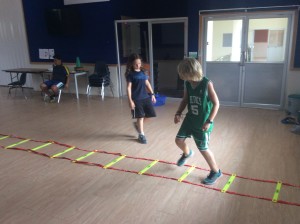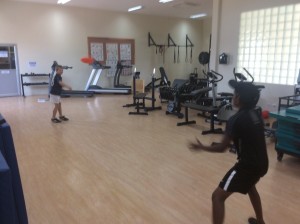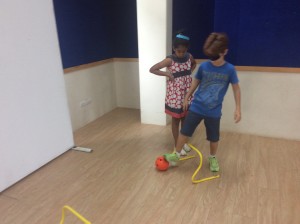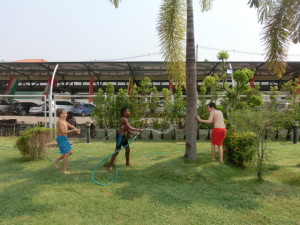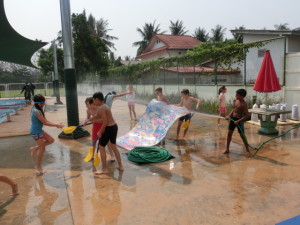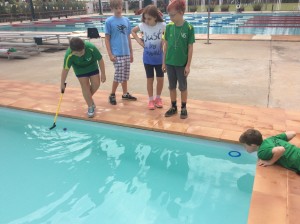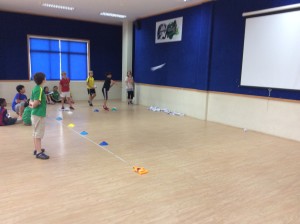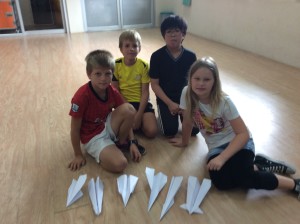Sharing The Planet – Challenges faced by children
Grade 4 inquire in to the challenges faced by children around the world with regards to sport & physical activity.
As this is not a typical “PE” unit, I fell a little background information will help set the context. This unit connects with the students classroom inquiries, as they explore challenges that various children around the world face depending on their country, race, health, socio-economic status etc. In PE lessons, we will make similar inquiries and try to put ourselves in the position of others who are often less fortunate than ourselves, just from a PE or physical activity perspective. We want to provoke thought and discussion that continues between the classroom and in the sporting arena.
Central idea: Children worldwide encounter a range of challenges, risks, and opportunities
Key concepts:: Form, Responsibility, Reflection Related concepts: Empathy, perseverance
Lines of Inquiry: 1. Challenges, risks and opportunities that children encounter (local and global). 2. How children respond to challenges, risks and opportunities. 3. How communities support children’s rights.
During this first session I decided to begin by discussing the unit details (above) with the students. Asking them their thoughts and understanding of the central idea and lines of inquiry help to gather some prior knowledge and gets the lesson moving. I wanted to get some ideas out on a board and simply asked, “What are some challenges related to PE, playing sport or just being active that children might face?” The photographs below are two separate boards from the two grade 4 groups I teach. I will now make them in to a poster for each class with more room available so we can add words and ideas throughout the unit.
To get the students moving (and minds in to gear), I set up a number of basic physical tasks for the students to complete in pairs. There were five different stations: students stepping though an agility ladder, kicking a ball through small hurdles, weaving in and out of cones on scooter-boards, mini 10 pin bowling and throwing a Frisbee back and forth. The students divided in to pairs and took turns at each station as seen in the photographs below.
Stepping through the agility ladder Mini 10 pin bowling
mini soccer through hurdles That is an orange ‘soft’ Frisbee flying
Scooter-board runs through the cones.
Following a period of about 10 minutes I called the students back together as a group and asked them to vote/judge how easy or hard the tasks were to complete. We decided on a simple 1-10 voting system where number 1 is indicates extremely easy and 10 indicates extremely hard and discussed each challenge. All students voted around 1,2,3 out of 10 for all of the tasks and agreed that they were simple for them to complete. I then told the students they would be doing the tasks again but this time a little different….Blindfolded. One of the challenges as listed by both classes that children might face is the issue of blindness and of course I knew there was a good chance that this would be listed and decided on this task beforehand, if it didn’t come up I would have had to introduce it. Students divided in to pairs again and this time, one person would be blindfolded while their partner would act as their guide, giving them instructions and preventing any injuries. We took about 15 minutes this time to get around to all stations.
Hard to see but he is blindfolded Through and didn’t trip over
Throwing was easier than catching! Leading& clapping to make noise to follow
Verbally guiding through the ladder
To conclude the lesson, the students gathered back around the whiteboard and we made the connection back to the issue of blindness that had been listed by the students. I then explained how we would undertake similar learning experiences in PE each week to highlight similar issues, mainly ones that the students had listed on the board and that they generated interest in from week to week. Therefore, next weeks PE lessons and blog post will be related to one of the issues from the whiteboards in the photos above which challenges me to come up with learning experiences that connect to these issues, so I have my homework to do this week.
Week 2 – Financial Equality
As mentioned at the end of the previous week, I wanted to turn one of the ideas the students came up with in to a learning experience related to the unit of inquiry but from a PE perspective. Looking back at the board, one of the clear issues that stood out for me was that of finances and access to equipment, as a student stated, “Some children might not have enough money to play sport if they can’t buy the things they need for the game.” The issue of financial equality related to challenges faced by children is one that will be prominent throughout their unit and therefore I wanted to continue the unit from there.
My homework and research for this unit led me to an experiment conducted by Jane Elliot who conducted the “Brown eyes – Blue eyes” experiment in her classroom in the late 1960’s. The experiment was conducted to highlight the realities of discrimination as experienced by the students in the classroom as they were divided and treated differently according to their eye colour. The experiment demonstrated how quickly children can succumb to discriminatory behavior. More information can be found through her website: http://www.janeelliott.com/
In her experiments, Jane had the students divided by eye colour and were treated differently over a long period of time. In my class, I only had the students for a lesson and quickly wanted to have a similar impact on the students. I decided to break the class in to three groups and divided them by hair colour so it was quick and less obvious. Group 1 were blonde haired students, group 2 students had brown/red hair while group 3 were all students with black hair. As the students entered the room, I sent them to a separate area with a numbered cone. I instructed the students that today they would be doing a short work-out for 15 minutes in the area that I assign them. The could only use the equipment allocated to them in their area and they should do a short stretch first before beginning. Seeings though we had recently completed a Health related fitness unit, the students should be able to work independently or in pairs for the time given. I showed the groups their areas which were deliberately different to try and begin provoking a response by the students.
Group 1 had an empty space to exercise Group 2 had a space and some skipping ropes
Group 3 were granted access to the gym equipment and could be seen by groups 1 & 2
Group 3 students began with great enthusiasm and ran directly towards the equipment while groups 1 and 2 quickly began commenting on how “unfair” it was. I decided to simply sit down near a small white board and begin recording comments the students made related to the exercise. Before too long, the group 2 students began skipping with their ropes while group one students began running around playing tag and they did need reminding to stay in their area only. I continued to walk around to all groups listening for comments about their feelings/attitudes. Below is a quick video of my the other class in their different groups and it was interesting to note that both group 1 students (from the different classes) chose to use their space to play tag.
After the 15 minutes were up, I asked the students to come together to try and discuss the issues at play. I began by reading out the comments that the students themselves had made that I had recorded. Below is photos of the two different boards from both classes in grade 4.
The discussion essentially followed the pattern of the comments made by the students. They were quick to pick up on the experiment and noted how it was unfair but as it was such a short period of time, they weren’t actually affected or actually disheartened by the exercise, unlike the experiments conducted by Jane Elliot in the 60’s and 70’s. The students were however able to demonstrate empathy to a point where they agreed that there is an unequal balance and distribution of wealth which relates to all parts of life which includes access to PE and playing sport, or simply having fun. Living in Laos, our students do understand their family’s position and socio-economic status and were quite sincere with their comments about this issue and were even beginning to think of ways in which they could tackle this problem in the future.
Week 2 Update: Swim Lesson
Today I had both grade 4 groups for their regular swim lesson. As I try to do with as many units as possible, I want to connect the unit of inquiry to the venue in which we’re learning and in this instance it is the pool. Instead of swimming laps to “get better” at swimming, I thought a few lessons with a different twist will help drive this unit. For their second lesson this week, I wanted to continue with the same theme as earlier, financial inequality decided to divide the students by having them draws straws. Before drawing, we quickly discussed the phrase and its’ meaning before the students literally either drew a short or long straw to indicate their position, this time only two groups, privileged or disadvantaged.
The students immediately started reacting to their ‘position’ before even knowing the activity which was the first note I wrote down on my clipboard to discuss later on after the exercise. I then instructed the privileged students to go ad enjoy the swimming pools and any equipment they wished as long as they were being safe, I had both our PE and swim assistant teachers to help supervise the pool. I then informed the disadvantaged students that they were not allowed to use the pools or equipment but asked them what they could do if this was a reality for them, if they didn’t actually have a pool to use. I asked them to think about what they might have seen living in Laos with children of their age who might be in that situation. It didn’t take long before the students thought about using the hoses to cool themselves off and play under. Below are some photos of the first part of the lesson.
The ‘disadvantaged’ students playing with hoses, simply squirting and running around
The ‘privileged’ students immediately went for the tubes and floating mats
I continued to walk between the different groups recording their conversations and activities for later discussion. The first thing I noted was that the ‘disadvantaged’ kids were having just as much, if not more fun than the students in the pool. However, after about 7-8 minutes, a few different things began to happen and behaviours changed, in both classes! For starters, the students were now referring to one another as ‘rich’ and ‘poor’ kids and the privileged students started commenting about how the ‘poor’ students were wasting water. I asked them what they thought they would normally do about it and they then set about telling the disadvantaged students to turn the water off, which is when the bickering began! When the ‘rich’ kids approached the ‘poor’ to tell them to stop wasting water, they were simply hosed down and told to go away.
Both classes saw the privileged kids try and stamp their authority over the disadvantaged
Soon after this, the disadvantaged kids thought had kind of had enough of hosing one-another down and went about starting to take items from the equipment cage close by. Without any instruction, a number of the privileged students starting telling the others off and tried to send them away which only saw the disadvantaged students try and take more. Before too long, all of the students from both camps were involved in a mini battle which I didn’t let last too long, but long enough to have an impact. Below are some more photos from the final stages of the exercise.
Fins being stolen & thrown about and students wanting the mats for a slip and slide
Our final discussion following this battle for equipment essentially followed the description of the exercise above. We started with the drawing of the straws and discussed their feelings and expectations before moving on to their initial choices of using the hoses and tubes/mats. Almost all students agreed that playing with the hose in this case was actually a little more appealing because it is something we do not normally let them do in the pool area while they have had access to the tubes and mats before. The discussion then turned to the debates about wasting water and the way in which they were communicating and the feelings towards the other group members. The next part of the discussion was of the final stage of the exercise, when the disadvantaged students began trying to take equipment. Many of the students commented about how they were playing up a little in the exercise and exaggerating but agreed that the sentiment was still there, they probably wouldn’t react well to others using and taking their equipment. Whilst it was once again a short exercise, there was some impact on the students as they were aware of how quickly they turned on one another and how their communication and behavior changed when divided.
Week 3: Geography
For this session, I decided to focus on the issue of geography and consider the challenges different children around the world might face due to their location and local environment. Again, trying to consider this issue within a sporting context is what I am aiming to achieve within my 40 minute lesson, so it is no simple task. However, I knew that if I tried to keep the ideas simple, we should be able to come up with some sort of provocation for the students so I took a walk around campus to consider the geography of our school. Before too long, I started thinking about the students performing the same physical task just in different environments that could represent different countries/landscapes. For example, the long jump pit could represent desert like countries, the swimming pools could represent flooded areas, the basketball court or football field could represent general land. Now, I had to think of an activity or some type of sport.
I decided to take another walk for inspiration but this time through PE shed to look at equipment and I came across some plastic putt-putt golf equipment that hadn’t been opened yet and it clicked straight away that this could be an activity that could work. Golf is a game played all over the world but different countries have different challenges with golf due to geography but most importantly for this exercise, playing putt-putt golf would surely be totally different for each group in those different locations around the school. For the actual lesson, I decided to break the students up in to 3 groups straight away and send them to their different areas with a teach or assistant and some golf equipment. One group played on the front court where the ball rolled nice and smooth, another group through the long jump area and the final group had to play golf in the pool. The students were instructed to see which team could come up with the lowest score as a group after everyone had a chance to play, following this, we would meet up again as a group for a discussion.
Our overgrown long jump pit & small pool were hard surfaces to play putt-putt golf on
The ball rolled well on front court.
The students all took turns to hit the ball from the tee off area to the hole which was to be located around 4-5 meters away. Scores were recorded for individuals and each group added their numbers to get a final team score. Below is a video of each group performing in their environment.
Group 1: Putt-Putt golf in the desert (long jump pit)
Group 2: Putt-Putt golf in flooded areas (pool)
Group 3: Putt-Putt golf on dry land (front court)
The first part of the final discussion saw the students discussing scores, which group won and the fairness of the competition before the students started discussing similar situations. For example, my European students talked about the fact they no longer go skiing unless the fly to snow for a holiday and my Australian students all discussed missing out on beach type activities living here in Laos in a land locked country. After discussing how these issues may affect them personally, I asked them to consider how other children in other countries might be affected, particularly those living in a country that may be considered a third world country. The first issue raised here connected to our local environment and the issue of land mines in Laos and the students were able to make the connection that some children face the challenge of playing sport or having fun in an environment littered with land mines and other dangers. The conversation continued from there with the students discussing war-torn areas, drought or flood affected countries and simply what types of sports were conducive to different environments. We didn’t have time to finish with any games for the students this lesson, but they didn’t seem to mind and continued discussing the issues at hand as they left for snack time.
Week 4: Education
This weeks session followed a similar format to the previous provocations, where students would be divided and experience different challenges whilst trying to participate in PE. The issue of children gaining equal access to education is one that has been widely discussed in the classroom this week and I therefore decided to connect with that theme. I once again managed to come up with a simple activity that would hopefully connect well with the students, even if it wasn’t the most ‘sporting’ or physical competition but a paper plane construction and flying experiment helped to paint a picture for the students.
The students were divided by their birth months, Jan-Mar in one group, Apr-Jun in another etc, so there were four groups in all. The students were instructed to create as many different designs as possible that actually flew, not to create as many planes as possible. The first group was given plain paper with no other help, the second group received plain paper and a single A4 print out showing a number of different designs of paper planes. The third group received plain paper and some iPad’s to share while the final group received A4 paper plane designs, complete with instructions and dotted lines to fold along. The students were given 10 minutes to create as many different possible designs as possible which would later be tested for flying. Below are some photos of the students creating their designs.
Group 1: Plain paper only, no resources Group 2: A4 print out to help copy from
Group 3: Used iPad’s to find designs Group 4: With step by step instructions.
It was fairly clear to the students as to what was happening as they had experienced similar provocations in the previous weeks. One student even remarked, “I’m in the poor group with nothing again.” What was different to my initial expectations was what happened with the groups that were given greater resources. Groups 1 & 2 were very restricted and had little help, group 3 had to do their own research while group 4 simply needed to followed the instructions, dotted lines and churn out as many as possible however, it didn’t really work like that. Group 4 seemed fairly disinterested in the task and didn’t even finish half of the sets they were given. Group 3 who were required to inquire for themselves were excited about the task and immediately went and found websites, pictures and videos on youtube. They followed video tutorials showing how to fold and create planes while the other groups chatted a lot of the time as they worked and it showed with group 3 clearly producing the highest number of planes.
For me, it was one of those moments when I stopped, reflected and thought to myself, ‘Of course the inquiry based model was going to be better!’ I had initially thought group 3 would spend too much time looking up planes and designs on the internet and I thought group 4 would get themselves in to a factory production like mode but this didn’t happen. It seemed following someone else’s instructions on paper, simply following the dotted lines and being given designs was not as energizing as being able to inquire for yourself and it was clear in their attitudes and application throughout the exercise. Once the 10 minutes were up, the students in group 3 proved themselves by producing the most different types of designs, however there was still the flying to be happen. The students decided that the planes should actually be able to fly and the distance of 4 meters for grade 4 students was agreed upon.
Group 1 planes falling short while group 3 planes soared a bit further in distance.
The photos below depict the students in their groups with their successful planes that were different in design and cleared the 4 meter mark.
Group 1 girls with 3 successful planes Group 2 only had 5 designs & they all worked!
Group 3: 10 different designs, 6 successful Group 4: 6 designs, only 3 successful
The final discussion initially focused on the difference in resources the students had access to, with group 1 & 2 pointing out the iPads and instructions given to groups 3 & 4. There even seemed to be a little tension at one stage as the students felt frustrated they couldn’t compete fairly and I quickly asked them to consider how that feeling or attitude might translate to the real world. There were a few seconds of silence which almost became awkward before one of the students commented about how he could understand a bit clearer, from this exercise, how children around the world face different challenges they might not personally encounter.
Week 5: Unsafe Areas
As this unit (Sharing the planet) has progressed in their classroom, the students inquiries have led them to learn about and discuss the issues surrounding Syria, ISIS and refugees. The issue of war and children in war torn areas was listed on our initial whiteboard as well, meaning that this week would be a good time to explore this issue in PE. I had previously been dividing the students and treating them differently to highlight issues but I couldn’t think of any ways to create a learning experience like that, with the issue of war/unsafe areas being the focus. I decided to try and keep it simple and think locally and considered Laos. Whilst there is currently no conflict in this country, there are many unsafe areas with fields of land mines littered all over. Football (soccer) is a popular sport world wide and Laos is no exception and the issue of children being injured from land mines whilst playing football is indeed a reality in here.
Whilst I wanted to create some sort of game to highlight this issue for my students, I knew there was no way in which we could even come close to have the students actually feel unsafe/threatened. My idea therefore was to have the students participate in a few small games of mini-football in our indoor area. In the first few rounds, they would play in an open space which represents children playing in a safe open field. Following this, I changed the court and put small soft cones all over the field which represented land mines. The students initially thought they might have to role play a little, like losing a leg if they stood on a cone accidentally and then hop on one foot, but I didn’t want the acting to get out of hand and decided to not go down that path. Instead, we would simply play football and count the number of times the students either accidentally stood on a cone or if the ball hit the cone and tally up the total to simply highlight the issue. Below are some photos and videos of the games.
At first, the field was open and free to play with the students safe from any danger
The next round of matches was played on a field littered with land mines in the form of cones. Unfortunately, the video below doesn’t show the ball hitting the cones too many times but in each of the 3 minute matches played, the count got up to around 7-8 “explosions.”
The final discussion actually ended up being more of a sharing of thoughts and feelings. A number of the students demonstrated empathy with some heart felt comments and showed that the issues discussed in the classroom and experienced in PE had made an impact on them. Some of the students’ parents actually work in the UXO (unexploded ordnance) sector and shared stories and statistics that they were knowledgeable about. Whilst this was probably the least life-like recreation so far this unit, I believe the message still got through and the issues regarding children facing life in unsafe/war torn areas, like those in Laos may be the continued direction for this unit leading up to the summative assesment tasks.





